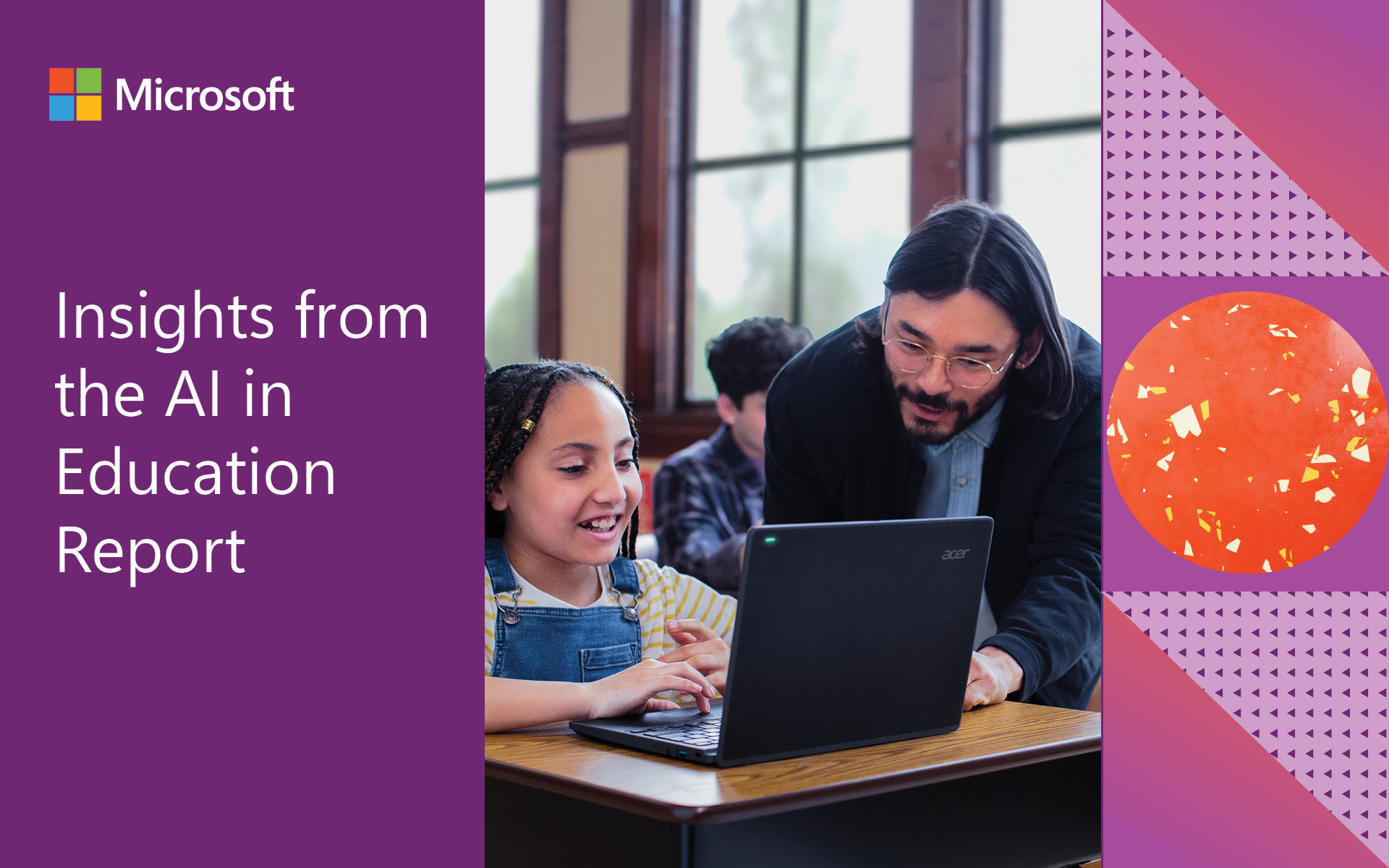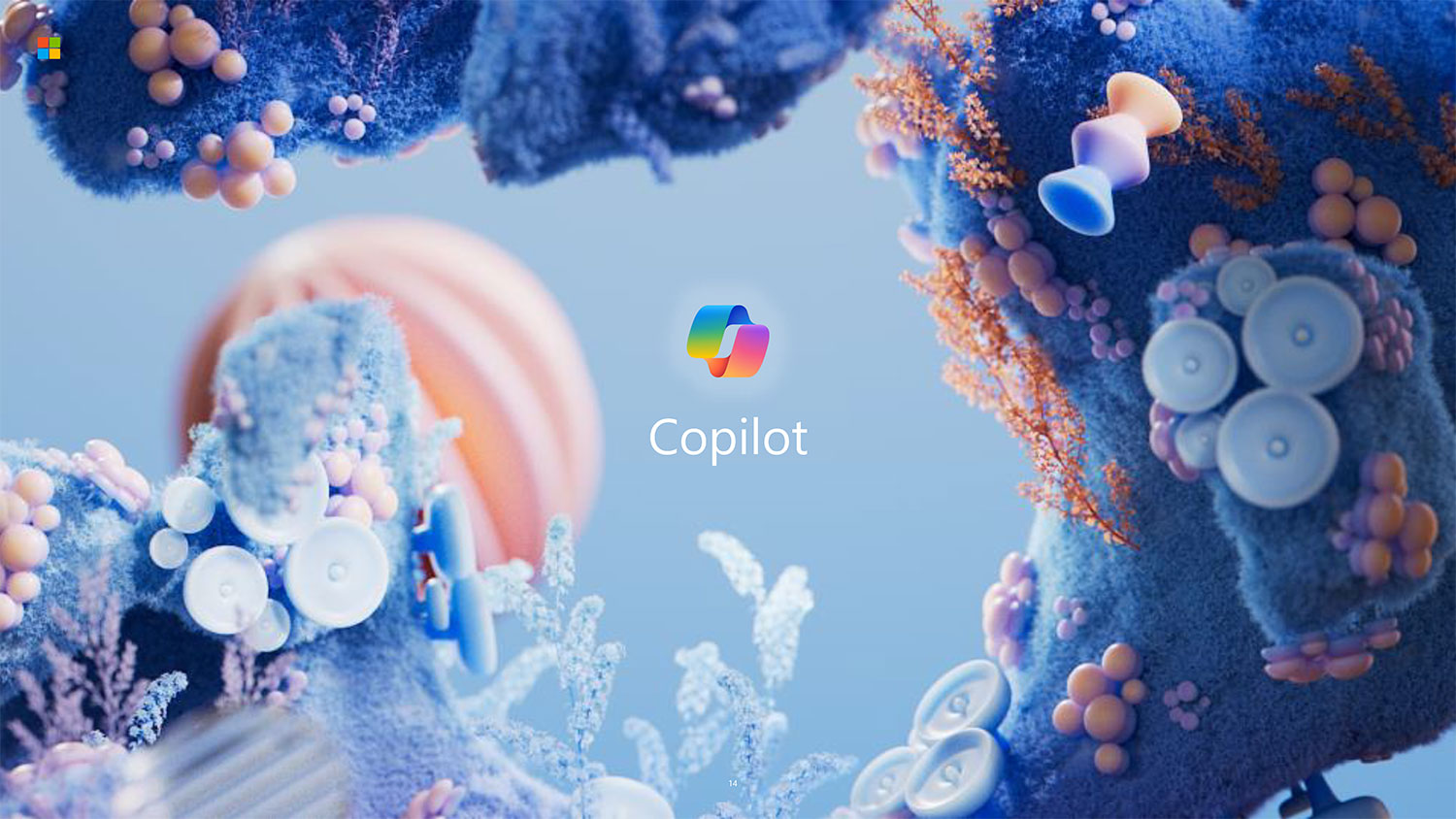The swift rise of generative AI is reshaping how schools approach creation, problem-solving, learning, and communication. Your schools are in a pivotal moment when critical thinking and metacognitive skills are more important than ever as new technology develops.
As we continue to learn, Microsoft believes it is important to share our early findings from our AI in Education Report. In this report, we highlight insights from our research, as well as research from partner organizations.
Key takeaways from the AI in Education Report include:
- Start AI conversations today. There is an urgent need to communicate clearly and openly about AI, increase AI literacy, and create usage guidelines at educational organizations.
- Learn how AI can help. There is a clear opportunity for AI to help educators and administrators lighten workloads, boost productivity, and improve efficiency.
- Explore new ways to learn with AI. Early studies demonstrate the potential of AI to improve educational experiences and learning outcomes.
- Prepare for the workplace of the future. Students need to build people skills and technical capacity to prepare for a world transformed by AI.
Explore the AI in Education Report for resources and recommendations that help represent the opportunities that come with this unique moment.
Start AI conversations today
When you’re getting started with using AI tools, it’s common to begin with figuring out ways to make everyday tasks easier. In education, AI also brings opportunities to provide actionable insights, improve learning outcomes, and make more time for human connection and collaboration. But there are also challenges to navigate and overcome to realize that potential. To better understand the needs and opportunities around AI in education, Microsoft surveyed educators, academic and IT leaders, and students from K-12 schools and higher education institutions about their perceptions, familiarity, uses, and concerns around AI tools.
Sample findings from the survey include:
- 47% of education leaders use AI every day
- 68% of all educators have used AI at least once or twice
- 62% of all students have used AI at least once or twice
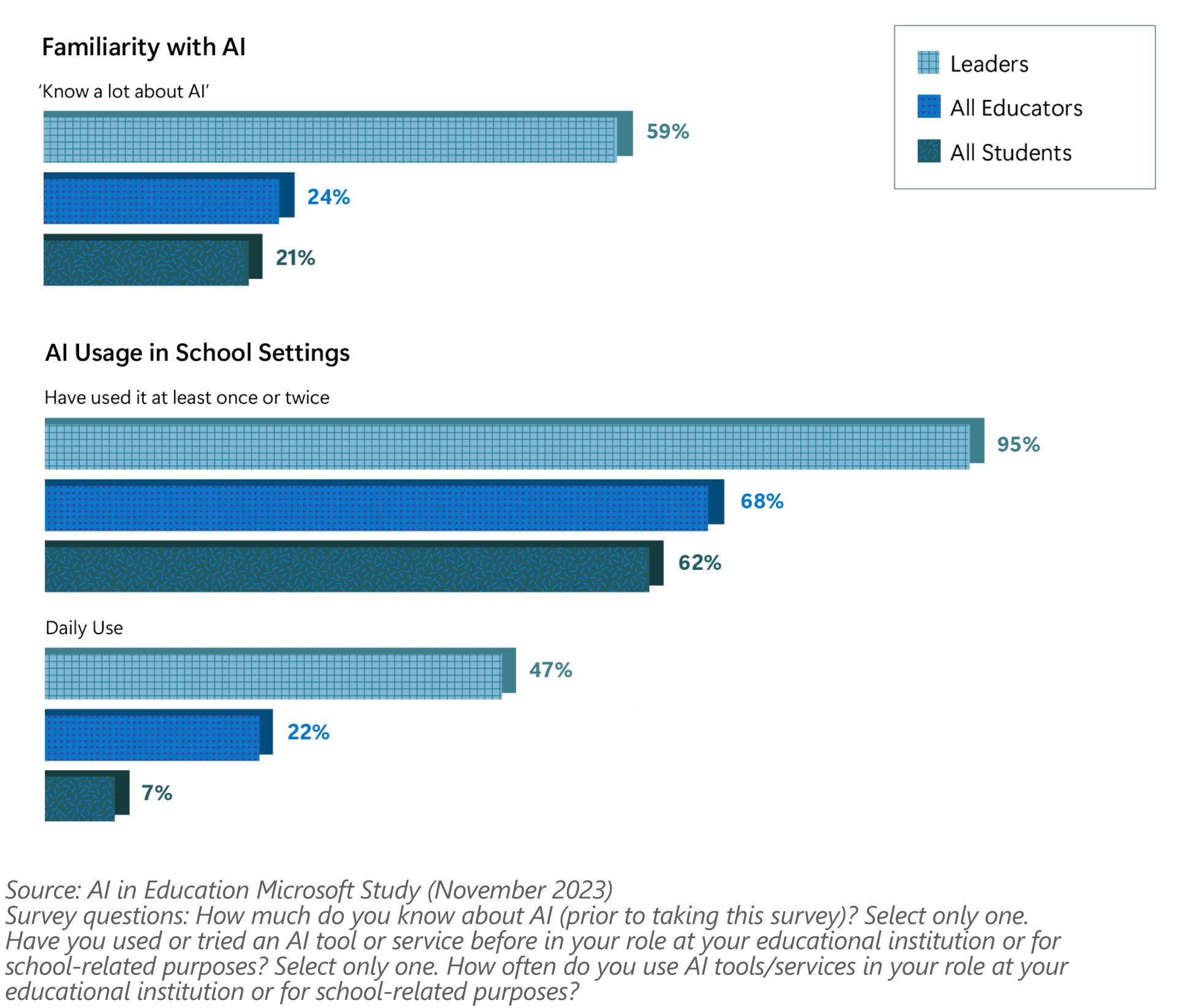
Survey results from the AI in Education Report show a comparison of the familiarity and usage of AI between leaders, all educators, and students in school settings. It highlights the significant difference in daily use of AI among these groups.
Despite generally low familiarity with AI, especially among students, it’s noteworthy that respondents from each group are using AI. This widespread adoption underscores the need for clear guidance and practical frameworks to help navigate the complexities of AI in education. Concerns about cheating are prevalent across all groups, including students, further highlighting the importance of establishing transparent and consistent guidance.
Take these next steps to start AI conversations at your school or institution:
- Request that your school or district leaders create clear guidelines and policies and provide professional learning opportunities. Consider sharing the TeachAI Toolkit as a resource.
- Help students learn how to use AI responsibly without compromising their academic integrity by setting clear expectations.
Common ways that generative AI tools are used in schools
AI can enable personalized learning, free up time for educators to focus on what matters most, and help address issues of equity and accessibility. It can also improve operational efficiency, bringing much-needed support to overburdened administrators and IT teams. There is a clear opportunity for AI to help educators and administrators lighten workloads, boost productivity, and improve efficiency.
Among respondents who report using AI, some of the most common tasks they use it for include:
- Leaders use AI tools mostly to improve efficiency of operational and administrative processes, improve access to resources, support communication with students, and identify opportunities for student improvement.
- Educators use AI tools mainly to create or update lesson plans, brainstorm new ideas, simplify complex topics, free up their time, and differentiate instruction to address students’ needs.
- Students use AI tools mostly to summarize information, help them brainstorm, get answers or information quickly, get initial feedback, and improve their writing skills.
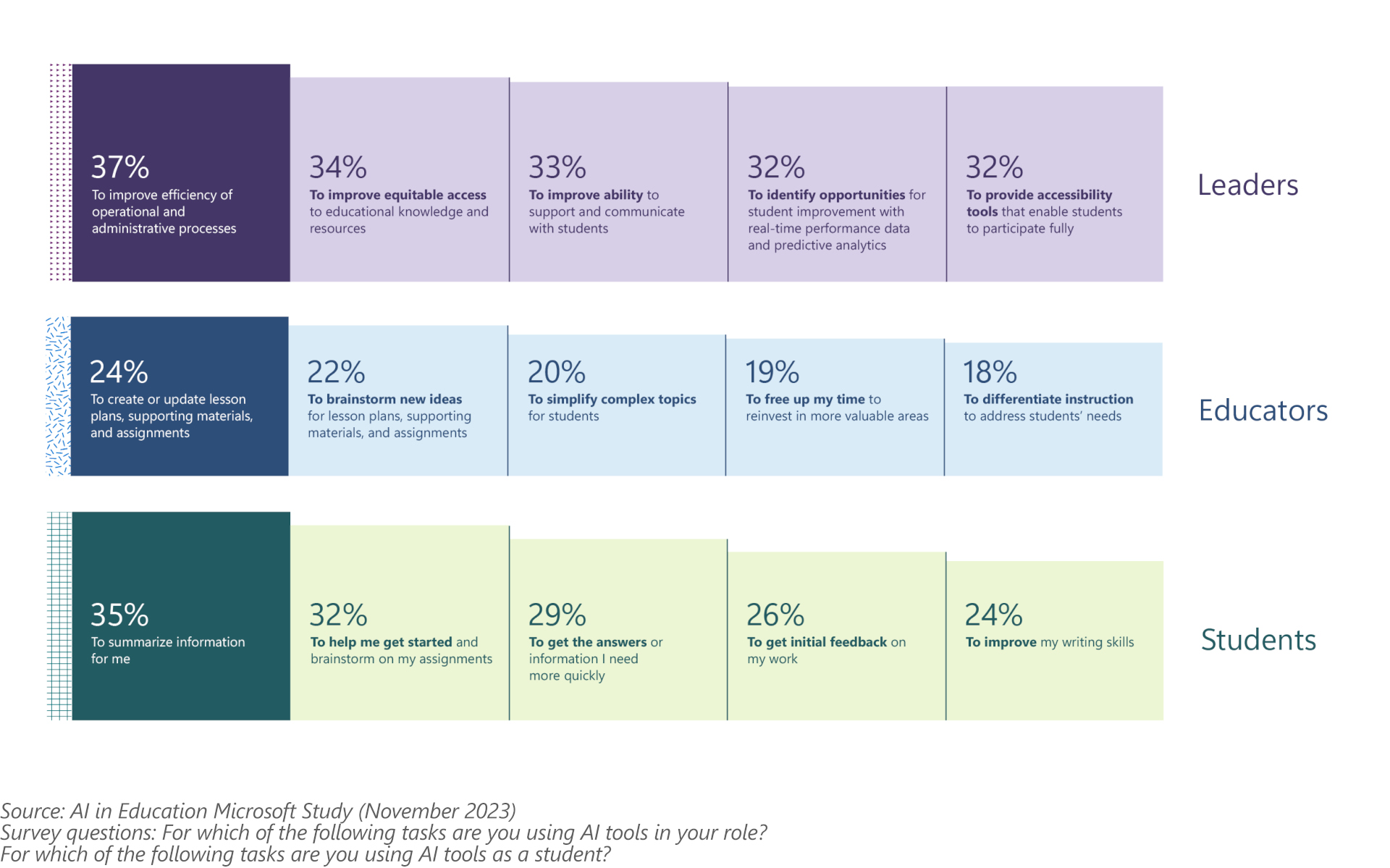
Survey results from the AI in Education Report show the widespread use and potential of AI in enhancing learning experiences and outcomes for different roles.
Learn how AI can help your school
Each month, the heaviest Microsoft 365 Education users receive hundreds of emails and chat messages to get things done. AI can enable greater productivity in tasks like lesson planning and curriculum development, which make up 45% of teachers’ responsibilities. That frees up time for educators to do the things only humans can do—like connect with students.
Educational institutions are moving fast when it comes to AI, and they’re seeing significant returns on their investment. However, an IDC study on the opportunity of AI in education found that education leaders feel less prepared for AI-driven change than their peers in other industries.
Education organizations can take these steps to increase preparedness and develop a strategy:
- Establish a guiding committee that defines and steers AI strategy, responsible use policies, governance models, and priorities.
- Prepare for change by building a centralized, cross-functional AI team that can connect AI initiatives to the organization’s existing priorities and create training opportunities.
- Prioritize high-value, low-complexity AI use cases. Start small, collect, and respond to feedback, and plan for scalable and impactful solutions.
To hear more IDC insights from a Microsoft sponsored study, explore the following resources:
- Read Education’s AI Journey Behind the Headlines
- Watch AI’s Impact in Education Extends Far Beyond the Classroom
Explore new ways to learn with AI
Students and educators alike have already made a discovery about the benefits of using generative AI in the classroom, particularly when used as a personalized academic coach that encourages learning and engagement rather than simply giving responses.
Explore these key takeaways from early studies about the potential impact of generative AI on learning:
- In December 2023, Microsoft Research and Harsh Kumar of the University of Toronto discovered that AI-generated explanations enhanced learning compared to solely viewing correct answers. The advantages were most significant for students who first attempted problems independently before receiving assistance.
- A 2023 study by Harvard University and Yale University professors found that AI chatbots can give students in large classes an experience that approximates an ideal one-to-one relationship between educator and student.
One student shared that it “felt like having a personal tutor...I love how AI bots will answer questions without ego and without judgment, generally entertaining even the stupidest of questions without treating them like they’re stupid.”
Take these next steps to explore how AI can support student learning:
- Model and encourage a growth mindset that includes learning, iteration, and curiosity.
- Learn from others and explore educational AI resources.
- Be intentional in your design of new AI experiences. What is your goal and how might AI help you achieve it?
Prepare for the workplace of the future
Workplaces, like classrooms, have been altered by the rise of generative AI tools. As a result, the skills that students need to learn have changed, too.
Important findings about the evolution of workplace skills include that 82% of leaders surveyed for Microsoft’s 2023 Work Trend Index say employees will need new skills to be prepared for the growth of AI. And learning to work alongside AI won’t just be about building technical capacity. It will be necessary to prioritize people skills, and new analytical, emotional, and critical thinking skills. According to the 2023 LinkedIn Future of Work Report, 92% of U.S. executives agree that people skills are more important than ever.
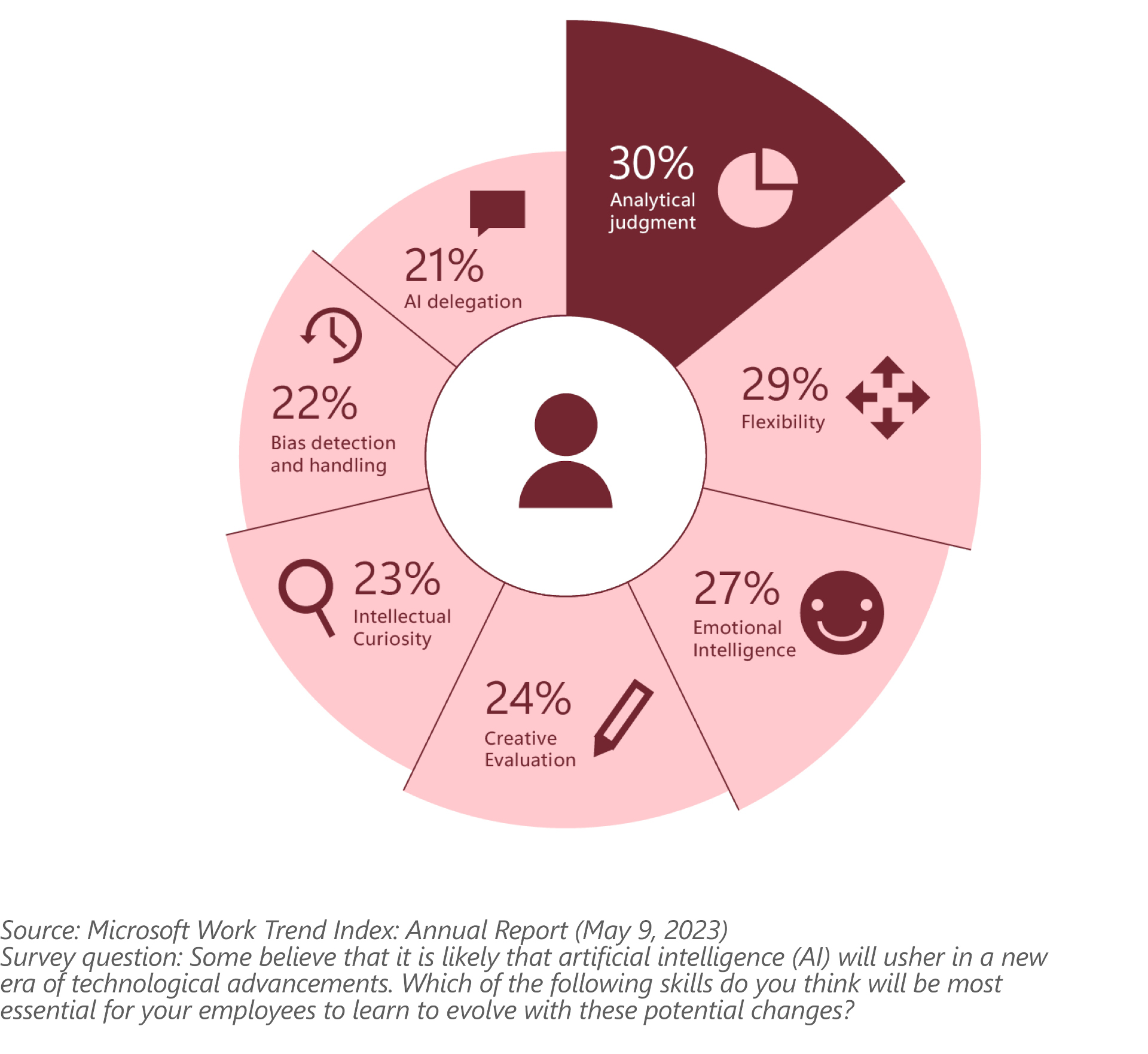
Survey results from Microsoft’s 2023 Work Trend Index show that skills like analytical judgment, flexibility, emotional intelligence, creative evaluation, intellectual curiosity, bias detection and handling, and AI delegation will be essential.
Take these steps to help prepare your students for future-ready skills:
- Teach students metacognitive and human-centered skills including the ability to analyze, understand, and control their own thought processes. You can start by asking students why they agree or disagree with AI-generated content.
- Model using AI tools to spark discussion and explore alternative views instead of only providing answers.
The rapid ascent of generative AI is revolutionizing how schools foster creativity, approach challenges, and enhance learning. Discover insights, resources, and recommendations in our AI in Education Report to seize the potential of this transformative era.

